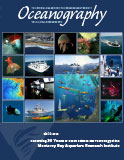Article Abstract
The lava flows produced by eruptions at Axial Seamount in 1998, 2011, and 2015 were mapped at 1 m resolution from autonomous underwater vehicles (AUVs) developed at the Monterey Bay Aquarium Research Institute (MBARI). A portion of the flows erupted in 2011 and 2015 are defined by pre- and post-eruption AUV surveys. Data processing software, also developed at MBARI, precisely coregisters pre- and post-eruption surveys to allow construction of difference maps by subtracting a pre-eruption grid from a post-eruption grid. Such difference maps are key to extracting detailed information about eruptive processes and emplacement of the lava flows. All three eruptions began on the east side of the caldera, and each produced ~25 × 106 m3 of thin channelized flows (with sheet lava channels, lobate lava interiors with pillars, and distal inflated pillow lobes) in the caldera and on the upper south or north rifts. The 1998 and 2011 eruptions propagated down the south rift, and the 2015 eruption propagated down the north rift. The 2011 and 2015 eruptions formed shallow grabens surrounding new non-eruptive open fissures on the east rim of the caldera and produced thick hummocky flows on upper to mid rifts, and the 2011 eruption also produced a thick hummocky flow on the lower south rift. Future eruptions at Axial Seamount will likely follow this pattern, regardless of which rift is the locus of the eruption.

